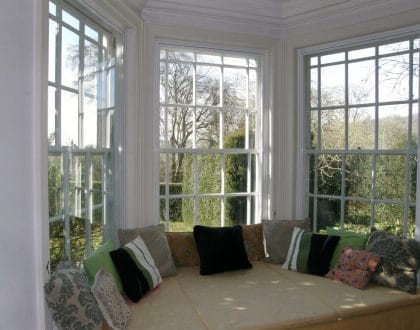How to Soundproof Windows with Secondary Glazing

Your home should be a haven after a busy day and employees are entitled to a quiet, comfortable working environment. But if you are plagued with outside noise, it can be difficult to be productive at work and relaxed at home. Soundproofing windows is the obvious solution. But if you’re someone who has never soundproofed anything before, where do you start?
Secondary glazing could be the answer. It’s an effective method of reducing noise, as well as giving extra security and improving heat loss. Read on as we explore how to soundproof windows effectively.
What is secondary glazing and how does it benefit windows?
Secondary glazing is a second layer of glass that is added to the primary windowpane. The difference is that there is a bigger gap between both panes, compared to double or triple glazing.
A secondary glazing frame is attached to the side wall of the window, positioning it slightly more apart from the primary window – an effective way of improving soundproofing.
Installing secondary glazing in your home or commercial building has quite a few benefits including:
Acoustic insulation
Soundproofing protects your home or commercial building from noise pollution and improves your level of privacy and comfort. Adding secondary glazing is an extremely effective way of reducing the noise levels you can deal with, for example, traffic, neighbours, noisy dogs and even flight path noise.
It is easily fixed to the existing primary window, leaving you with two panes of glass with an optimal gap in between. The bigger that cavity is, the more chance of reducing noise, due to the dampening effect.
You can also use acoustic glass to absorb more sound than standard glass. However, it’s not always necessary to use acoustic glass if you make sure the air gap is wide enough between the regular glass panes.
Thermal insulation
Similar to acoustic insulation, the space between panes with secondary glazing is a big plus. Air is trapped between the panes, which in turn traps heat and keeps any from escaping. Installing secondary glazing is a proven way of keeping a comfortable temperature throughout your home.
Condensation removal
Adding secondary glazing will decrease the amount of warm damp air reaching the primary window – reducing the likelihood of condensation. As long as the secondary glazing is properly sealed and the cavity is ventilated, you are unlikely to have a condensation problem.
Enhanced window security
Secondary glazing is a popular way to increase security as the extra pane of glass immediately strengthens your windows. The frames that attach the glass to the window are made from aluminium and securely fixed to ensure they can’t be forced open. Because you can also lock the secondary pane from the inside, it will leave you with a window that is virtually impossible for intruders to open – making potential thieves think again.
How to get the best soundproofing results
Having secondary glazing is a great way to soundproof windows. When it comes to unwanted outside noise, it can easily travel through windows. Unless they are strengthened in some way, you will have to deal with different types of noise pollution.
The good news is that adding a second pane to your windows will give you a reduction in 80% of the noise entering a room. It is a simple and straightforward method to improve acoustic insulation and give you that peace and quiet you long for.
To get the best results, it’s important that there is as much space as possible left between the two panes. The flow of air will increase the performance of your glazing and keep damp from spreading. The bigger gap means you are creating a larger barrier for sound to get through, making it softer and weaker by the time it gets across the space.
In short, the wider the gap, the better sound insulation you will get. The recommended size is at least 100-150mm between panes – or even 200mm to really make sure you get a high soundproofing performance.
If, however, your window doesn’t have a large amount of available space, consider using acoustic glass which is designed to absorb sound better than standard glass panes.
Benefits of soundproofing with secondary glazing
More effective than other types of glazing
Secondary glazing comes out on top in comparison with double and triple glazing for soundproofing. With the right acoustic secondary glazing, you’ll get a reduction of at least 50 decibels, which is 5 times more than either double or triple glazing. This is achieved by making the gap between panes significantly bigger than any double or triple-glazed panes.
No need for a window replacement
If you like the sound of secondary glazing, there’s no need to attempt a huge replacement job. A great benefit of secondary glazing is that it can be fixed to existing single, double and triple glazing and instantly improve your soundproofing. And all without having the disruption of replacement, allowing you to keep the original style of your windows.
Extra advantages
Not only will secondary glazing soundproof your home, it’ll also help in other areas. As mentioned, it reduces heat loss, as well as providing increased security – giving you a quieter, warmer and more secure home.
Block out the noise with Clearview
If the sound of silence is an appealing thought, why not consider secondary glazing with Clearview? Our expert team has over 20 years of experience installing quality soundproof windows across Sheffield and beyond. With our excellent installation service, secondary glazing is added to your window giving you extra soundproofing, insulation and security.
Clearview offers a 10-year guarantee with our high-performance products and will make sure that your installation meets all your soundproofing needs. And if you prefer the idea of high-quality DIY secondary glazing, we provide a fully assembled and installation-ready kit for domestic and commercial customers across the UK.
So if you would like to speak to our friendly team about soundproofing your property, simply contact us at [email protected] or request a Fast Quote online.
Recommended Posts

Top Tips For Soundproofing Your Bedroom
08/07/2025


